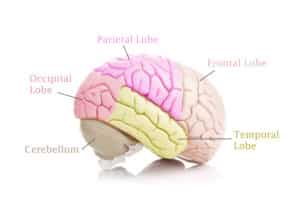Although the human brain is surrounded by protective fluid and encased in the hard shell of the skull, it is still possible for it to be severely injured or damaged. Thanks to modern technology, we are beginning to arrive at what still may be a primitive understanding of the various parts of our brains, how they function, and how traumatic injury affects patients’ ability to regain some or most of their ability to function.
When you look at a clear sky and are able to discern its blue color, you are using the occipital lobe. Located at the back of the brain, the occipital lobes are responsible for visual perception. Damage to them results in loss of visual capability, an inability to identify colors, and hallucinations. At times, patients experience severe vision loss or total blindness.

As is the case with other traumatic brain injuries, damage to the occipital lobe most often occurs as a result of vehicle crashes, falls, and firearms. Taking steps to prevent these injuries could save you or a loved one a lifetime of the added stress and depression that accompanies traumatic brain injuries. These include: always wearing seat belts; making sure children are in safety or booster seats at all times; wearing helmets when biking, riding a motorcycle, scooter, sled, snow mobile, etc. or when playing contact sports; removing tripping hazards around your home; using non-slip shower mats; installing rails on both sides of stairways, and making sure there is good lighting throughout your home. However, once brain injuries occur, there is no cure. The goal of treatment and rehabilitation is to assist the patient in strengthening the skills he or she continues to possess, while helping to find compensatory strategies for adaptation of those that are lacking.
Brain Injury Specialists
When an individual is suspected to have a traumatic brain injury, a team of specialists assembles to guide the patient and family through the recovery process. In most cases, this group consists of several persons. A physiatrist, skilled in neurology and orthopedics, will use techniques of physical and medical rehabilitation to help the patient to regain as much functioning as possible. A neuropsychologist will run tests to ascertain what aspects of “competence” have been lost as a result of the injury. The patient’s motor functioning, including strength, balance, coordination and movement, will be assessed by a physical therapist, who will suggest exercises and strategies for improvement. A speech consultant will be called in to focus on helping the patient with skills of expression, comprehension, and communication.
Finally, a social worker generally acts as a liaison to facilitate dialogue among the patient, family, and various team members. Initially, a number of tests are conducted to accurately determine the location and extent of the injury and to assess what skills and abilities may have suffered. These measures include magnetic resonance imaging (MRI), computer tomography (CT scans), x-rays, and other specialized tests. A team of specialists is assembled to guide the patient and family through the recovery process.
After the initial assessments have been conducted, the patient will generally undergo a period of rehabilitation, the duration and intensity of which will depend on the severity of the patient’s injuries. Since the occipital lobe handles visual functions, treatment will involve strategies designed to help the patient understand his or her perceptual limitations and to compensate for them whenever possible. In the case of severe vision loss, additional specialists such as orientation and mobility instructors may be consulted to provide the patient with alternative techniques for functioning in the home and travelling in indoor and outdoor areas.
Because each injury is unique and affects its victim differently, a good treatment plan will be one that enables recovery to occur in a way and at a pace that is comfortable for the patient. Throughout what can often be many months of frustrating and grueling rehabilitation intervention, care must be taken to include family members in as many of the discussions and practical instruction sessions as possible. Consistency and communication across disciplines are two of the most essential ingredients in a successful rehabilitation plan.
As was stated above, the goal of this multi-disciplinary intervention is not to eliminate all signs of traumatic brain injury, but instead to assist the patient and family members in understanding the new reality in which they will live. Patience and perseverance will be absolutely essential for all involved. Since occipital lobe damage causes marked deficits in visual perception and functioning, a patient might have to thoroughly overhaul many of his or her most basic coping and human relations strategies. By no means will this process be easy. However, with the care and expertise of all members of the team, the patient can often improve far above and beyond his or her expectations.
Brain Lobe Injuries
Frontal Lobe Brain Injuries: https://brainandspinalcord.org/frontal-lobe-brain-injury/
Occipital Lobe Brain Injuries: https://brainandspinalcord.org/occipital-lobe-brain-injury/
Temporal Brain Lobe Injuries: https://brainandspinalcord.org/temporal-lobe-brain-injury/
Parietal Brain Lobe Injuries: https://brainandspinalcord.org/parietal-lobe-brain-injury/
